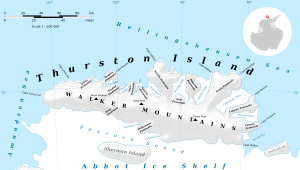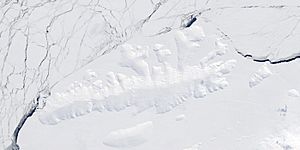Walker Mountains facts for kids
The Walker Mountains (72°13′S 99°2′W / 72.217°S 99.033°W) are a group of mountains and nunataks in Antarctica. A nunatak is a mountain peak that sticks out above the ice or glacier around it. These mountains are spread out but generally run from east to west. They form the main "spine" or backbone of Thurston Island.
These mountains were first seen by Rear Admiral Richard E. Byrd and his team from the US Antarctic Service (USAS). They spotted them during a flight from their ship, the Bear, on February 27, 1940. The mountains were later named by US-SCAN (a group that names places in Antarctica) after Lieutenant William M. Walker. He was the captain of the ship Island during the United States Exploring Expedition on March 23, 1839.
Contents
Exploring the Walker Mountains
The Walker Mountains are a key feature of Thurston Island. They help us understand the geography of this part of Antarctica. Scientists and explorers often study these kinds of mountain ranges. They learn about the Earth's history and how ice sheets change over time.
What Makes Up the Mountains?
The Walker Mountains are made up of many different peaks and bluffs. A bluff is a steep, broad cliff. These individual parts help define the overall shape of the mountain range. Each peak has its own unique features.
Notable Peaks and Bluffs
Here are some of the important peaks and bluffs that make up the Walker Mountains:
- Mount Borgeson
- Mount Bramhall
- Mount Caldwell
- Dickens Peak
- Mount Hawthorne
- Mount Kazukaitis
- Landfall Peak
- Mount Leech
- Litz Bluff
- Mount Lopez
- Lowe Nunataks
- Mount Noxon
- Parker Peak
- Mount Simpson
- Smith Peak (Antarctica)
- Zuhn Bluff
Mapping and Research
Mapping these remote areas of Antarctica is very important. It helps scientists create accurate maps and study the land. Organizations like the United States Geological Survey (USGS) help with this work. They gather information to make detailed maps of places like the Walker Mountains.
![]() This article incorporates public domain material from the United States Geological Survey document "Walker Mountains" (content from the Geographic Names Information System). Lua error in Module:EditAtWikidata at line 29: attempt to index field 'wikibase' (a nil value).
This article incorporates public domain material from the United States Geological Survey document "Walker Mountains" (content from the Geographic Names Information System). Lua error in Module:EditAtWikidata at line 29: attempt to index field 'wikibase' (a nil value).



